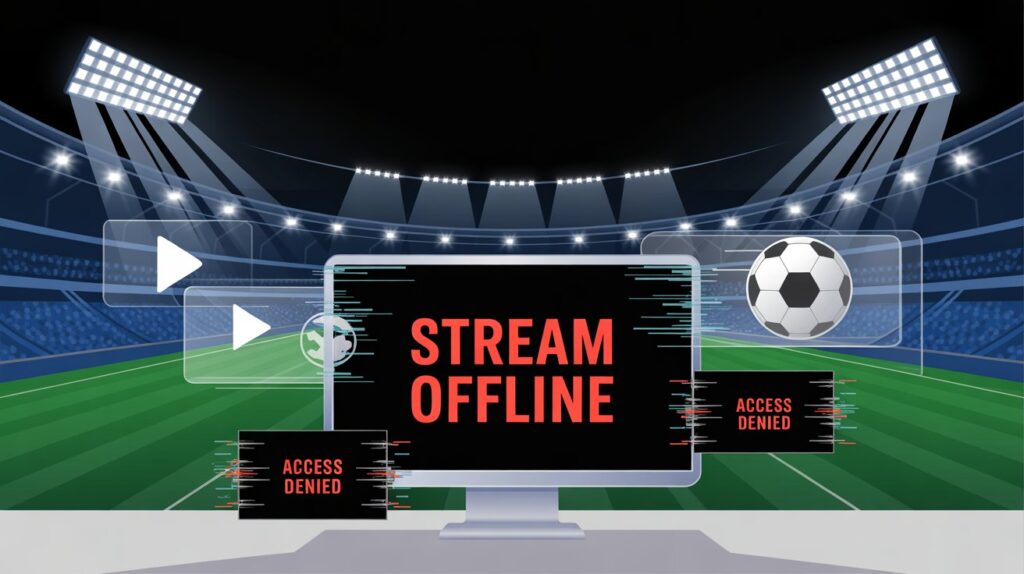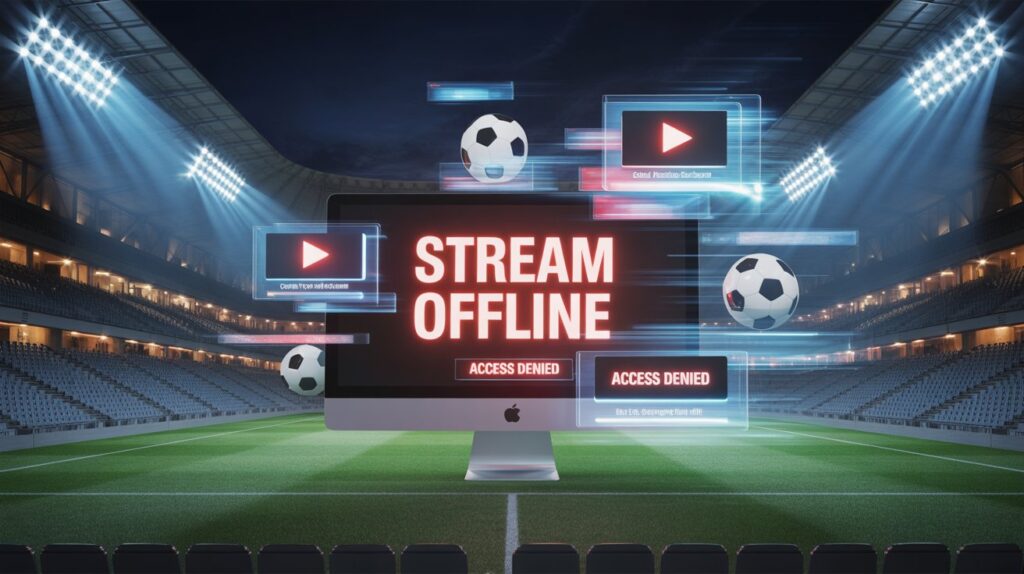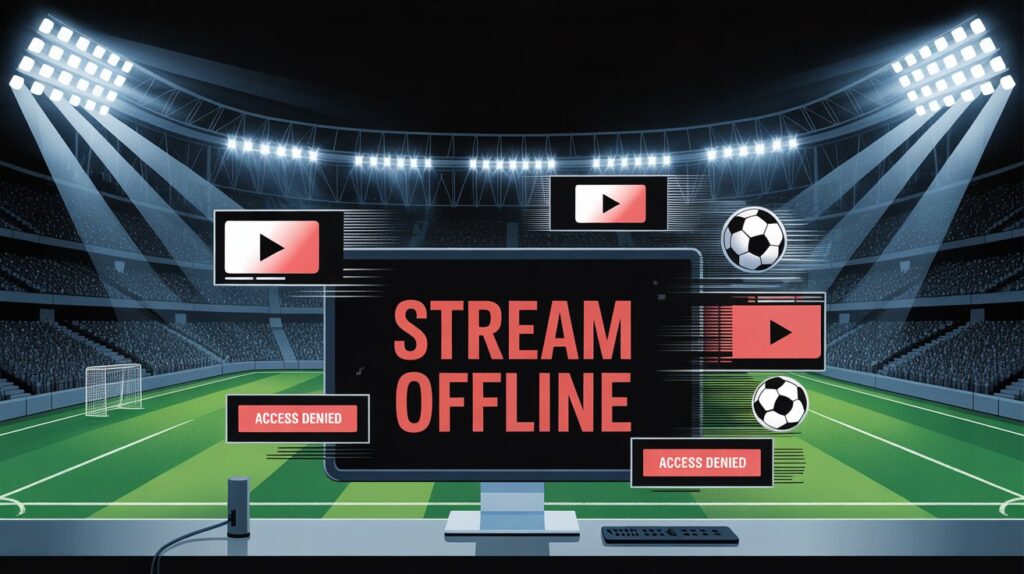For years, millions of soccer fans across the world relied on a shadowy network of free sports streams to watch their favorite teams play. Among these sites, Streameast rose above them all — a sleek, fast, and seemingly reliable platform that offered live access to everything from the Premier League to the UEFA Champions League, without requiring a paid subscription.
By 2024, Streameast had quietly grown into a giant of the online sports-piracy world, recording over 1.6 billion visits in a single year. For fans tired of expensive streaming services and fragmented broadcast rights, it was a digital haven. For rights holders and broadcasters, however, it represented billions of dollars in lost revenue and a growing legal nightmare.
In late 2025, international authorities and anti-piracy groups finally brought Streameast down in a coordinated global crackdown. The operation sent shockwaves through the sports-streaming landscape — and left fans wondering what happens next.
This article explores how Streameast became so influential, why it was shut down, and what soccer fans need to know about the risks of illegal streaming and the safe, legitimate alternatives now available.
What Was Streameast?
Origins and Rapid Growth
Streameast began as a small sports-streaming portal in the early 2020s, part of a wave of sites promising free access to live events that were otherwise locked behind paywalls. While its exact founders remain anonymous, digital-forensics reports suggest that it operated through a network of mirror domains and proxy servers, allowing it to bypass regional restrictions and stay online despite repeated takedown attempts.
Within a few years, Streameast became synonymous with free live soccer. It offered links to:
-
English Premier League (EPL) matches
-
UEFA Champions League and Europa League
-
FIFA World Cup qualifiers and international friendlies
-
La Liga, Serie A, Bundesliga, Ligue 1, and MLS
Unlike older, spam-filled sites, Streameast presented a cleaner interface, high-definition streams, and fewer intrusive ads. It even mimicked the design of legitimate streaming services, creating a false sense of professionalism and safety.
Why Soccer Fans Loved It
Soccer is the world’s most watched sport — yet access to live matches remains fragmented and expensive. In many countries, fans need multiple subscriptions (for example, to Peacock, Paramount+, and ESPN +) to watch all major leagues. Streameast filled that frustration gap:
Pain Point for Fans |
How Streameast Appealed |
|---|---|
High subscription costs |
100 % free access to live matches |
Geo-restrictions |
Streams available globally via mirror sites |
Complex apps and logins |
One-click web playback |
Match delays or blackouts |
Real-time live links across multiple sources |
In short, Streameast became the “Netflix of illegal sports”, offering convenience and global access — but without the legality or safety of licensed platforms.
How Streameast Operated Behind the Scenes
The Infrastructure
Investigations revealed that Streameast’s network relied on dozens of domain names, many of which were hosted in jurisdictions known for weak copyright enforcement. The operators used content delivery networks (CDNs) and reverse-proxy services to mask server locations.
Streams were often rebroadcasted from legitimate feeds captured using IPTV capture tools or illegal decoder cards. Advertising was the site’s primary revenue stream, with millions in profits generated through:
-
Banner ads and pop-ups from offshore ad networks
-
Redirects to gambling and betting platforms
-
Malvertising (ads that install malicious software)
-
Cryptocurrency donations and affiliate links
This model allowed Streameast to profit from pirated content while keeping its operators largely anonymous.
Legal Gray Areas and Evading Enforcement
Streameast’s administrators changed domains frequently — shifting from .com to .xyz, .app, and other extensions. When one was blocked, mirrors would appear overnight. Some versions operated on the dark web, accessible via Tor browsers.
Because users technically “clicked” on third-party streaming links rather than directly hosting them, Streameast claimed limited liability — a tactic used by many piracy sites. However, under modern copyright law, facilitating illegal access is still a criminal offense.
The Crackdown: How Streameast Was Finally Shut Down
The Global Sting
In mid-2025, the Alliance for Creativity and Entertainment (ACE) — a coalition of major media and sports organizations — launched a coordinated action against Streameast. The operation involved digital-forensics teams, domain registrars, and law-enforcement agencies across multiple countries.
Within weeks, more than 80 domains linked to Streameast were seized. Visitors were redirected to an official seizure notice explaining the site’s illegality. Servers were taken offline, and investigations into its operators reportedly continue.
Impact on Users and Industry
The shutdown immediately disrupted millions of habitual users. Social media and Reddit forums filled with questions like “Why isn’t Streameast working?” and “Where can I watch soccer now?”
Meanwhile, broadcasters and anti-piracy advocates hailed the operation as a major victory. Analysts estimate that shutting down Streameast helped recover tens of millions of dollars in lost broadcast revenue — though other copycat sites soon appeared.
The Hidden Dangers of Illegal Streaming
Despite its appeal, Streameast came with serious risks — many of which casual users never realized until too late.
1. Legal Consequences
In numerous countries, viewing or sharing pirated streams can constitute a criminal offense. Users caught accessing illegal sites may face:
-
Fines or penalties for copyright infringement
-
Legal notices from ISPs
-
Potential loss of internet service
-
In severe cases, criminal prosecution
2. Cybersecurity Threats
Piracy websites are notorious for malware and data theft. Streameast’s advertising networks were linked to:
-
Trojan downloads disguised as video players
-
Phishing pop-ups stealing payment or login data
-
Cryptocurrency-mining scripts running silently in browsers
A 2024 cybersecurity report found that one in three piracy-site users encountered malicious content capable of compromising personal information.
3. Privacy Risks
Because Streameast operated outside of any legal jurisdiction, there was no data protection or user transparency. Visiting these sites could expose your IP address, browsing history, and personal identifiers to hackers or law enforcement.
4. Quality and Reliability Issues
While Streameast offered impressive HD streams at times, users often dealt with:
-
Broken links and low-quality feeds
-
Sudden takedowns during matches
-
Delayed or unsynced commentary
-
Buffering issues due to overloaded servers
The experience was ultimately inconsistent — far from the reliability of legitimate broadcasters.
Legal and Safe Alternatives to Watch Soccer Online
For fans seeking reliable and lawful ways to watch soccer, there are now more options than ever. Legitimate platforms offer HD quality, full replays, and mobile apps — all without the legal or security risks of sites like Streameast.
Region |
Legal Soccer Streaming Platforms |
Coverage Highlights |
|---|---|---|
United States |
Peacock, Paramount+, ESPN+, Fubo, Apple TV+ |
EPL, Champions League, La Liga, MLS |
United Kingdom |
Sky Sports, TNT Sports, Amazon Prime Video |
Premier League, European competitions |
Europe |
DAZN, Canal+, Eleven Sports |
Multiple leagues and UEFA tournaments |
Asia & Middle East |
beIN Sports, SonyLIV, Star Sports Select |
EPL, UCL, AFC competitions |
Africa |
SuperSport, Showmax Pro |
Premier League, CAF tournaments |
Latin America |
ESPN, Star+, Claro Sports |
European and local leagues |
Pakistan & South Asia |
Tapmad, ARY ZAP, SonyLIV |
Premier League, UEFA, local leagues |
Most of these services now offer flexible monthly subscriptions, student plans, or match-pass options — making legitimate viewing more accessible than ever.
Why Soccer Piracy Persists
Even with abundant legal options, piracy remains widespread. Understanding why fans turn to illegal platforms helps explain Streameast’s popularity — and why similar sites keep emerging.
1. Fragmented Rights and Subscriptions
Soccer broadcasting rights are divided among numerous networks. To watch all competitions, fans often need multiple subscriptions, each costing $5–$20 monthly. Many find that unsustainable.
2. Geo-Blocking and Availability
Certain matches or leagues are unavailable in some countries due to licensing restrictions. Streameast eliminated these barriers by offering global access.
3. Convenience and User Experience
Ironically, many legal platforms have cumbersome logins, app crashes, or regional ads. Streameast’s simplicity felt refreshing by comparison.
4. Perception of “Harmlessness”
Some users believe that “streaming” isn’t the same as “downloading,” assuming it’s not illegal. In reality, both are forms of copyright infringement.
Addressing these user frustrations is key to reducing piracy sustainably.
The Broader Impact on the Sports Industry
Financial Losses
Piracy costs the global sports industry over $25 billion annually in lost revenue. Broadcasters invest heavily in exclusive rights — and illegal streams directly erode that investment.
Job and Development Effects
Reduced revenue affects not just major leagues but grassroots programs. Fewer funds mean smaller clubs, youth academies, and community projects lose out.
Reputation and Security
Piracy links sports to illegal markets, gambling, and cybercrime. That association undermines the trust fans place in their clubs and broadcasters.
How Enforcement Is Evolving
Authorities are becoming increasingly sophisticated in combating sports piracy:
-
DNS and domain blocking: ISPs can block access to known piracy domains in real time.
-
Dynamic injunctions: Courts issue flexible orders allowing immediate action against mirror sites.
-
Watermarking technology: Identifies illegal rebroadcasts of live feeds.
-
AI-based monitoring: Detects and disables illegal streams during matches.
-
User education campaigns: Inform fans of the risks and promote legitimate platforms.
The Streameast case demonstrates that even large, distributed networks are not immune to coordinated enforcement.
The Ethics of Streaming: Beyond Legality
Beyond legal risk, piracy raises moral questions about fairness and value. Players, commentators, production crews, and leagues all depend on broadcast revenue. When fans choose illegal streams, they indirectly reduce the funds sustaining the sport they love.
Ethical consumption — paying for legitimate access — ensures fair compensation, better coverage quality, and investment in future generations of players.
Practical Tips for Soccer Fans
-
Compare Subscription Packages
Many services offer discounted annual or student plans. Combining one or two subscriptions often covers all major tournaments legally. -
Use Official Apps and Aggregators
Platforms like LiveSoccerTV list legitimate broadcast partners for each match, helping you find where to watch legally in your country. -
Watch Free Highlights on Official Channels
Major leagues upload free match highlights on YouTube and official apps. -
Avoid VPN-based Piracy
Some users think using a VPN hides illegal activity; however, many anti-piracy agencies track and penalize such behavior. -
Educate Friends and Communities
Sharing knowledge about risks and legitimate alternatives helps reduce demand for illegal streams.
Table: Comparing Streameast vs. Legal Soccer Streaming
Feature |
Streameast (Illegal) |
Legal Platforms |
|---|---|---|
Cost |
Free, ad-supported |
Paid (subscription or pay-per-view) |
Legality |
Fully illegal |
100 % legal and licensed |
Quality |
Variable; frequent buffering |
HD / 4K consistent streaming |
Security |
High malware and phishing risk |
Secure and ad-free |
Accessibility |
Mirrors, unstable links |
Reliable apps and websites |
Support |
None; anonymous operators |
Customer support and refunds |
Long-term availability |
Short-lived; domain takedowns |
Stable, ongoing access |
Frequently Asked Questions
1. Is Streameast completely shut down?
Yes. The original Streameast network and its main mirror domains were taken offline through coordinated international enforcement in 2025. However, new copycat sites may appear — users should treat them as unsafe and illegal.
2. Is it illegal to watch a soccer match on Streameast?
Yes. Even merely streaming unauthorized content violates copyright laws in most jurisdictions. Viewers can face legal consequences, especially if they share or promote such links.
3. Are there safe “free” ways to watch soccer online?
Some official broadcasters and leagues offer limited free access (e.g., highlights or selected matches). YouTube, FIFA+, and league-owned platforms provide legitimate no-cost viewing options.
4. Can using a VPN make illegal streaming safe?
No. While a VPN can mask your location, it doesn’t legalize or secure piracy. Authorities can still identify and prosecute illegal stream operators and users.
5. What happens if I already watched on Streameast?
Casual users are rarely targeted individually, but continuing to use similar illegal sites poses cybersecurity and legal risks. Transition to legal platforms immediately for safety.
6. Why can’t streaming services make soccer more affordable?
Broadcast rights are sold at extremely high prices. Services recoup costs through subscriptions and ads. However, many now offer flexible plans to balance affordability and legality.
7. How do I find which service airs a particular match?
Use verified listings like LiveSoccerTV, or check official league websites for licensed broadcasters in your region.
The Future of Live Sports Streaming
The fall of Streameast symbolizes a turning point in how sports content is distributed and consumed. As technology evolves, so does enforcement — but so must accessibility. The key lesson from the Streameast saga is not simply that piracy is punishable, but that fans crave convenient, affordable, and reliable access to the sport they love.
Broadcasters and leagues now face a challenge: to innovate faster than pirates, offering unified apps, region-wide access, and reasonable pricing models. Fans, meanwhile, must recognize their role in sustaining the ecosystem. Supporting legitimate streaming helps protect the integrity of soccer worldwide.
Conclusion
Streameast’s rise and fall reveal both the promise and the peril of the digital sports-streaming age. It thrived because fans demanded convenience — and faltered because it ignored the law. Its shutdown serves as a warning to users and operators alike: illegal access may seem free, but the risks and consequences are costly.
For soccer fans, the takeaway is clear. You don’t need piracy to enjoy the game. With today’s growing array of legal streaming platforms, on-demand replays, and global coverage, there are safe, high-quality ways to follow every kick and goal.
The beautiful game deserves a fair field — on and off the pitch. By choosing legal viewing options, fans help keep soccer strong, secure, and accessible for generations to come.












